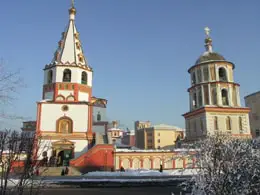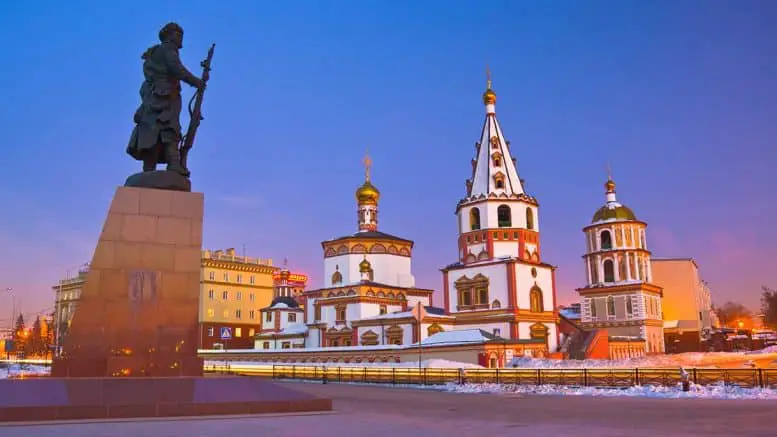
The land of Siberia brims with mystery and silence. Nearly incomprehensible size, it brims with natural resources, diverse ecologies and a myriad of peoples. Near the center of the southern bulge of its geographical mass lies the city of Irkutsk. Home to 600,000 people, the city has long been a center of culture and education, a hub for economic development, and a conduit connecting Russia’s great cities in the west with not only its strategically important Far East, but also connecting with the great economic markets of Asia.
The current population of Irkutsk and the surrounding land is comprised mostly of ethnic Russians and native tribal groups. The Buryat Nation is the largest cohesive entity among these groups. Descended from Mongolians who settled the area in the third century, the Buryat did not solidify as a nation until the seventeenth century, and only then, it seemed, as a way to better respond to the settlers and soldiers who were arriving from Russia.

Traditional Buryat dress is shown in the foreground, bottom left. A decorated yurt is seen in the background.
The Buryat have been fairly successful in maintaining their traditions. For instance, many still speak their native Mongol dialect. They are traditionally Buddhist or Shamanist (a pagan tradition), although some have converted to Christianity under Russian influence. As a rule, groups west of Lake Baikal have adopted Western dress, while groups east of the lake maintain more traditional cultures – continuing nomadic lifestyles and living in traditional yurts.

Siberia’s historically best known imports, of course, have always been prisoners and exiles. The Decembrists are probably the most famous, and romantic, of these Siberian exiles. They were a group of highly educated military officers who helped drive Napoleon out of Russia in 1812. They perceived the absolutist rule of the tsar as the source of many of the substantial problems that Russia was facing in the early 1800’s. In December 1825, they launched a coup with the intent of establishing a constitutional monarchy in Russia. However, they failed. Five ringleaders were executed, and 136 officers, the elite of the Russian nobility, were sent to Siberia.
Although the city was officially founded in 1686 (based on a settlement that had grown around a military fort at the same location starting ca. 1661), it would be these Decembrists who would grow Irkutsk into the cultural and intellectual center that it now is. Although the Decembrists were prisoners of the state and stripped of much of their wealth, they and their families helped bring modern European culture to what was still a developing land. They built schools, hosted balls, and held open discussions in their homes on a range of topics and issues. Their migration, though forced and restricted, established an intellectual and cultural link between the western Russian cities and the Siberian territories.
The Decembrists are still fondly remembered in Irkutsk and two house-museums, the former residences of the Volkonsky and Trubetskoy families are still immaculately kept as tributes to these people and their contributions to the city’s history.
Under Stalin, the government would again put Irkutsk and its surrounding regions to use as a location for prisoners in the twentieth century, setting up several gulags near the city. Maxim Gorky’s description of Siberia, a “land of chains and ice,” is still the image that many have of the region.

The Epiphany Cathedral was constructed in early eighteenth century and is one of Irkutsk’s oldest structures.
Aside from its history of political prisoners, Irkutsk has also had a rich industrial history. The region’s economy revolves primarily around metallurgy, mining, logging, and oil. During the Soviet era, the Russian government developed Irkutsk into an industrial capital. In the 1950’s and 60’s, a hydroelectric power cascade was built on the Angara River, and in the 1960’s the Baikalsk Pulp and Paper Mill was also built there. Both still function today: the mill employs around 3,500 people, and the power station, according to its website, produces 4.1 billion kilowatts per year. Despite the benefits this brings to the local population, the mill is a major source of pollution to the region and the dams, many say, have negatively impacted the region’s fragile and unique ecology. Also under the Soviet regime, the surrounding collectivized farms continued to produce grains and livestock, but mismanagement and inefficiency led to decreasing yields. After the collapse of the 1990’s, most of Russia’s agricultural and industrial complex also collapsed – the Irkutsk area included. The factories and farmland are still only functioning at a fraction of their capacity. While some investment is starting to trickle in to redevelop the area, the region’s potential is still largely unexploited.
Some of the investment has been controversial. Transneft, Russia’s state pipeline company, is currently constructing the Siberian-Pacific oil pipeline which is due to start pumping oil to a sea port on the Pacific in 2009. The pipeline was delayed by a command from then President Vladimir Putin to move it forty miles north due to environmental concerns raised by its proximity to the ecologically pristine Lake Baikal. This presidential command, many say, was partially prompted by a widespread and active outcry from the people of Irkutsk on the issue. The profit potential for transporting oil through the region is great. Rosneft, for instance, has also been negotiating with Japan, China, and India to export the region’s oil wealth to those energy-hungry countries.
The Russian government has also proposed building an “International Uranium Enrichment Centre” in nearby Angarsk. The project is supported both by the US government and the International Atomic Energy Agency, and is intended to help bring nuclear energy to developing economies that currently lack uranium enrichment facilities. While the facility would add to the region’s economy, and perhaps give poor countries an energy boost while keeping the potentially dangerous technology of uranium enrichment concentrated at a single location, scientists fear it could threaten the health of the habitat and residents around the plant.

The Okholopkov Drama Theatre is one of Irkutsk’s several theatres.
A recent Irkutsk city planning proposal has also sparked controversy. According to the plan, Irkutsk would be consolidated with the nearby cities of Angarsk and Shelekhov as well as several villages into a single “supercity” with more than one million people. This new municipal entity would then qualify for increased federal funds that would be used to improve the tourism and transportation infrastructure, creating a “prestigious place” that would attract still more labor and investment.
Detractors from the plan have argued that the new city would be too diverse and too spread-out to be effectively governed by a central authority or served by a single infrastructure; the move would boost Irkutsk economically, but leave other areas with smaller voice and essentially at the mercy of the authorities in Irkutsk.
Most agree that the city does have the potential to be a much more popular tourist destination, but needs infrastructure development – primarily in transportation and hotels. To host a substantially greater number of tourists, the city will need much more of both. To worsen the situation, much of the infrastructure currently in place was built during the Soviet era and is far from meeting the modern standards expected by today’s tourists.
Irkutsk’s greatest attraction is the world-famous Lake Baikal. Located between the Irkutsk and Buryat Oblasts and known colloquially as the “Blue Pearl of Siberia,” Baikal is the world’s largest, deepest, and perhaps still purest freshwater lake, holding 20% of the world’s surface fresh water. The water and surrounding forests are home to myriad animal and plant species including the ring seal (nerpa), sturgeon, and brown bears, many found nowhere else on earth.

Other reasons to visit Irkutsk include its architecture, which includes not only the onion-domed cathedrals for which Russia is famous, but also the intricate wooden architecture that is becoming harder and harder to find in the faster-growing cities of Moscow and St. Petersburg. Many of the houses built in this “rustic” style were built by the class of wealthy merchants that once populated the city, moving goods along the Silk Road. The city also has a vivrant literary scene (much of it inspired by local history and ecology), a relatively well-developed civil society (as can be seen in the activism surrounding Baikal), and an active youth culture (which can seen especially on the banks of the Angara River and the tree-lined pathways of Yunost Island).
Today, Irkutsk shares the plight of many Russian cities, still reeling from the after-effects of communism. Irkutsk is still revered as a place of awesome natural beauty and a jewel of culture in the midst of Siberia. However, it is greatly in need of upgrades to its infrastructure and investments in developing its surrounding resources if it is to continue to be an economic hub. If to retain its beauty, it will also need businessmen and officials willing to make those investments in a responsible and sustainable fashion.
Video on SRAS’s Irkutsk-Based Programs!



